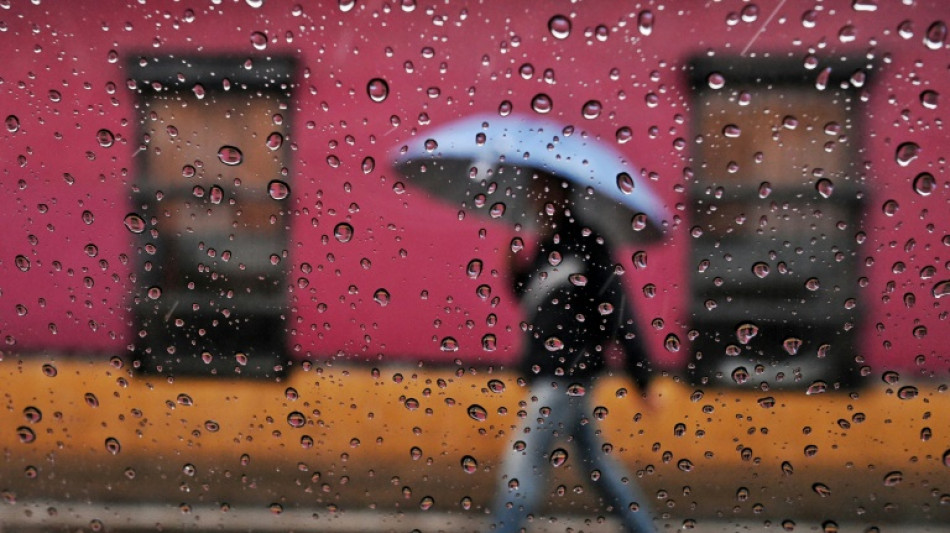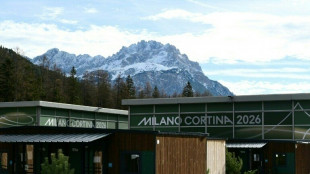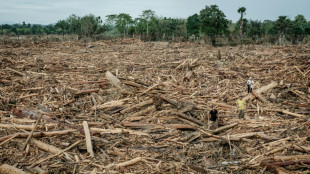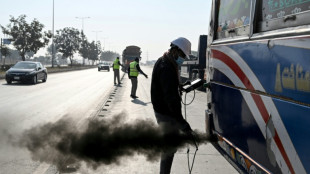
-
 Security beefed up for Ashes Test after Bondi shooting
Security beefed up for Ashes Test after Bondi shooting
-
Wembanyama blocking Knicks path in NBA Cup final

-
 Amorim seeks clinical Man Utd after 'crazy' Bournemouth clash
Amorim seeks clinical Man Utd after 'crazy' Bournemouth clash
-
Man Utd blow lead three times in 4-4 Bournemouth thriller

-
 Stokes calls on England to 'show a bit of dog' in must-win Adelaide Test
Stokes calls on England to 'show a bit of dog' in must-win Adelaide Test
-
Trump 'considering' push to reclassify marijuana as less dangerous

-
 Chiefs coach Reid backing Mahomes recovery after knee injury
Chiefs coach Reid backing Mahomes recovery after knee injury
-
Trump says Ukraine deal close, Europe proposes peace force

-
 French minister urges angry farmers to trust cow culls, vaccines
French minister urges angry farmers to trust cow culls, vaccines
-
Angelina Jolie reveals mastectomy scars in Time France magazine

-
 Paris Olympics, Paralympics 'net cost' drops to 2.8bn euros: think tank
Paris Olympics, Paralympics 'net cost' drops to 2.8bn euros: think tank
-
Chile president-elect dials down right-wing rhetoric, vows unity

-
 Five Rob Reiner films that rocked, romanced and riveted
Five Rob Reiner films that rocked, romanced and riveted
-
Rob Reiner: Hollywood giant and political activist

-
 Observers say Honduran election fair, but urge faster count
Observers say Honduran election fair, but urge faster count
-
Europe proposes Ukraine peace force as Zelensky hails 'real progress' with US

-
 Trump condemned for saying critical filmmaker brought on own murder
Trump condemned for saying critical filmmaker brought on own murder
-
US military to use Trinidad airports, on Venezuela's doorstep

-
 Daughter warns China not to make Jimmy Lai a 'martyr'
Daughter warns China not to make Jimmy Lai a 'martyr'
-
UK defence chief says 'whole nation' must meet global threats

-
 Rob Reiner's death: what we know
Rob Reiner's death: what we know
-
Zelensky hails 'real progress' in Berlin talks with Trump envoys

-
 Toulouse handed two-point deduction for salary cap breach
Toulouse handed two-point deduction for salary cap breach
-
Son arrested for murder of movie director Rob Reiner and wife

-
 Stock market optimism returns after tech selloff but Wall Street wobbles
Stock market optimism returns after tech selloff but Wall Street wobbles
-
Clarke warns Scotland fans over sky-high World Cup prices

-
 In Israel, Sydney attack casts shadow over Hanukkah
In Israel, Sydney attack casts shadow over Hanukkah
-
Son arrested after Rob Reiner and wife found dead: US media

-
 Athletes to stay in pop-up cabins in the woods at Winter Olympics
Athletes to stay in pop-up cabins in the woods at Winter Olympics
-
England seek their own Bradman in bid for historic Ashes comeback

-
 Decades after Bosman, football's transfer war rages on
Decades after Bosman, football's transfer war rages on
-
Ukraine hails 'real progress' in Zelensky's talks with US envoys

-
 Nobel winner Machado suffered vertebra fracture leaving Venezuela
Nobel winner Machado suffered vertebra fracture leaving Venezuela
-
Stock market optimism returns after tech sell-off

-
 Iran Nobel winner unwell after 'violent' arrest: supporters
Iran Nobel winner unwell after 'violent' arrest: supporters
-
Police suspect murder in deaths of Hollywood giant Rob Reiner and wife

-
 'Angry' Louvre workers' strike shuts out thousands of tourists
'Angry' Louvre workers' strike shuts out thousands of tourists
-
EU faces key summit on using Russian assets for Ukraine

-
 Maresca committed to Chelsea despite outburst
Maresca committed to Chelsea despite outburst
-
Trapped, starving and afraid in besieged Sudan city

-
 Showdown looms as EU-Mercosur deal nears finish line
Showdown looms as EU-Mercosur deal nears finish line
-
Messi mania peaks in India's pollution-hit capital

-
 Wales captains Morgan and Lake sign for Gloucester
Wales captains Morgan and Lake sign for Gloucester
-
Serbian minister indicted over Kushner-linked hotel plan

-
 Eurovision 2026 will feature 35 countries: organisers
Eurovision 2026 will feature 35 countries: organisers
-
Cambodia says Thailand bombs province home to Angkor temples

-
 US-Ukrainian talks resume in Berlin with territorial stakes unresolved
US-Ukrainian talks resume in Berlin with territorial stakes unresolved
-
Small firms join charge to boost Europe's weapon supplies

-
 Driver behind Liverpool football parade 'horror' warned of long jail term
Driver behind Liverpool football parade 'horror' warned of long jail term
-
German shipyard, rescued by the state, gets mega deal


What looming La Nina means for global temperatures
El Nino, the natural weather phenomenon that contributed to 2023 being the hottest year on record, has recently subsided, paving the way for its opposing, cooling La Nina phase to begin.
But in the context of a warming planet due to human-caused climate change, scientists say that cooling effect may be miniscule.
Here is how the cycle called El Nino-Southern Oscillation (ENSO) works to affect global weather:
- El Nino -
El Nino can weaken consistent trade winds that blow east to west across the tropical Pacific, influencing weather by affecting the movement of warm water across this vast ocean.
This weakening warms the usually cooler central and eastern sides of the ocean, altering rainfall over the equatorial Pacific and wind patterns that change temperature and rain around the world.
The extra heat at the surface of the Pacific releases energy into the atmosphere that can temporarily drive up global temperatures, which is why El Nino years are often among the warmest on record.
It occurs every two to seven years, and lasts nine to 12 months.
The latest El Nino, which began in June 2023, peaked among the five strongest such events on record, according to the World Meteorological Organization (WMO).
It typically results in drier conditions across southeast Asia, Australia, southern Africa, and northern South America, and conversely much wetter conditions in the Horn of Africa and the southern United States.
While it is unclear what impact climate change may be having on ENSO, it is affecting how these events play out, said Michelle L'Heureux, lead ENSO forecaster for the US NOAA weather agency.
Climate change is making extreme events more frequent and intense, and when colliding with ENSO can cause its associated drier or wetter conditions to "become more amplified", she added.
The elevated global temperatures ENSO causes also served as a "portal" into the future of climate change, L'Heureux said.
"It gives you... a bit of a preview of what a warmer world looks like because it is giving you a temporary boost. So we're now at a new level we haven't seen before," she said.
- Neutral period -
Although El Nino has been dissipating, the first four months of 2024 have continued to break heat records -- unsurprisingly as the cycle typically drives up temperatures the year after it develops.
ENSO is "not an on-off switch", L'Heureux explained. "It takes a while for the global atmospheric circulation to adjust."
Scientists anticipate that the neutral period between the two cycles will begin between May and July.
Above-normal temperatures are forecast to persist through July across the northern and southern hemispheres, with just equatorial regions anticipated to see near-to-below normal temperatures, according to WMO.
The neutral period is not likely to last long, L'Heureux explained.
Typically, after a strong El Nino as the world just experienced, La Nina soon follows.
- La Nina -
La Nina sees the eastern Pacific Ocean cool for a period of about one to three years, generating the opposite effects to El Nino on global weather.
It leads to wetter conditions in parts of Australia, southeast Asia, India, southeast Africa and northern Brazil, while causing drier conditions in parts of South America.
It can also contribute to more severe Atlantic hurricanes, and NOAA has forecast an "extraordinary" storm season ahead this year.
La Nina tends to bring down global temperatures, although L'Heureux warned against hopes of relief in areas like southeast Asia that have recently be battered by scorching heatwaves.
"The world is warming and ENSO is acting secondary to that," she said.
"Even this year with La Nina potentially developing, we're still expecting basically a top-five global mean temperature record," she said.
NOAA says there is a 69 percent chance of La Nina beginning sometime between July and September.
S.AbuJamous--SF-PST




